The American History from Ancient times to 1492
The Pre-Colombian era:
The pre-Colombian era incorporates all period subdivisions in the history and pre-history of the Americas before the appearance of significant European influences on the Americas continents spanning of the tome of the original settlement in the upper paleolithic period to European colonization during the Early modern period.
While the phrase "pre-Columbian era" literally refers only to the time preceding Christoper Columbus's voyages of 1492, in practice the phrase usually is used to denote the entire history of indigenous Americas cultures until those cultures were significantly influenced by the Europeans, even if this happened decades or centuries after Columbus's first landing. For this reason, the alternatives terms of Pre-contact Americas, Pre-Colonial Americas or Prehistoric Americas are also in use. In areas of Latin America the term usually used is Pre-Hispanic.
Many Pre-Columbian civilization established hallmarks which included permanent settlements,cities,agriculture, civic and monumental architecture, major earthworks, and complex societal hierarchies. Some of these civilization had long faded by the time of the first permanent European and African arrivals (late 15th and 16th centuries), and are known only through archaeological investigations and oral history. Other civilizations were contemporary with the colonial period and were described in European historical accounts of the time. A few, such as the Maya civilization, had their own written records. Because many Christian Europeans of the time viewed such text as heretical, men like Diego de Landa destroyed many text in pyres, even while seeking to preserve native histories. Only a few hidden documents have survived in their original languages, while others were transcribed or dictated into Spanish, giving modern historians glimpses of ancient culture and knowledge.
Indigenous American culture continue to evolve after the pre-Columbian era. Many of these people and their descendants continue traditional practices, while evolving and adapting new cultural practices and technologies into their lives.
Settlement of the Americas:
Asian nomads are thought to have enter the Americas via the Bering land bridge (Beringia), now the Bering strait and possibly along the coast. Genetic evidence found in Amerindians' maternally inherited mitochondrial DNA (mt-DNA) supports the theory of multiple genetic populations migrating from Asia. Over the course of millennia, Paleo-Indians spread throughout North and South America.
Exactly when the first group of people migrated into the Americas is the subject of much debate. One of the earliest identifiable culture was the Clovis culture, with sites dating from some 13,000 years ago. However, older sites dating back to 20,000 years ago have been claimed. Some genetic studies estimate the colonization of the Americas dates from between 40,000 to 13,000 years ago. The chronology of migration models is currently divided into two general approaches. The first is short chronology theory with the first movement beyond Alaska into the New world occurring no earlier than 14,000-17,000 years ago, followed by successive waves of immigrants. The second belief is the long chronology theory, which proposes that first group of people entered the hemisphere at a much earlier date, possibly 50,000-40,000 year ago or earlier.
Artifacts have been found in both North and South America which have been date to 14,000 BP, and humans are thought to have reached Cape Horn at the southern tip of South America by this time. The Inuit and related people arrived separately and at a much later date, probably during the first millennium CE, moving across the ice from Siberia into Alaska.
Ancient History of North America:
Early Paleo-Indians soon spread throughout Americas, diversifying into many hundreds of culturally distinct tribes. Paleo-Indian adaption across North America was likely characterized by small highly mobile bands consisting approximately 20 to 50 members of an extended family. These groups moved from place to place as preferred resources were depleted and new supplies were sought.
Paleo-Indian groups were efficient hunters and carried a variety of tools. these implements used for butchering and hide processing. During much of the Paleo-Indian period bands are thought to have subsisted primarily through hunting now-extinct mega fauna such as mastodon and bison antiques.
The North American climate finally stabilized by 8000 BCE; climate conditions were very similar to today's. This led to widespread migration, cultivation and subsequently a dramatic rise in population all over the Americas. Over the course of thousands of years, American indigenous peoples domesticated, bred and cultivated a large array of plant species. These species now constitute 50-60% of all crops in cultivation worldwide.
After the migrations, it was several thousand years before the first complex civilization arose, at the earliest emerging 5000 BC. Paleo-Indian inhabitants of the Americas were hunter-gatherers. Many Arctic, Subarctic, and coastal people hunted and gathered, while agriculture was adopted in appropriate regions. Within this time-frame roughly pertaining to the Archaic Period numerous archaeological cultures have been identified.
Due to the vastness and variety of the climates ecology, vegetation, fauna, and land forms, ancient peoples migrate and coalesced separately into numerous separate people of the distinct linguistic and cultural groups. According to the oral histories of many of the indigenous people of the Americas, they have been living there since their genesis, describe by a wide range of traditional creation stories.
MESOAMERICA in Ancient times
One of the pyramids in the upper level of Yaxchilan Atlantes at Tula,Hidalgo. Mesoamerica is the region extending from central Mexico south to the norhtwetern border of Costa Rica that gave rise to a group of stratified, culturally related agrarian civilization spanning an approximately 3,000 year period before the visits to the new world by Christoper Columbus. Mesoamerian is the adjective generally used to reefer to that group of pre-Coloumbian cultures. This refers to an environment area occupied by an assortment of ancient cultures that shared religious beliefs,art,architecture, and technology in the Americas for more than three thousand years.
Between 2000 and 300 BC, complex cultures began to to form in Mesoamerica. Some matured into advance pre-Columbian Mesoamerican civilization such as the Olmec, Teotihuacan, Maya, Zapotec, Mixtec, Huastec, Purepecha, Toltec and Mexica (also known as the Aztec, an incorrect name coined in the 19th century by Alexander Von Humboldt, the "Aztecs" are also know as the Triple Alliance. simce they were three smaller kingdoms loosely united together.
These indigenous civilizations are credited with many inventions: building pyramid-temples, mathematics, astronomy,medicine writing, highly accurate calendars fine arts, intensive agriculture, engineering, an abacus calculator, and complex theology. They also invited the wheel, but it was used solely as a toy. In addition they sued native copper, silver and gold for metal working, in which they used very advance methods.
Archaic inscriptions on rocks and rock walls all over northern Mexico demonstrate an early prosperity for counting. Their number system was based 20 and included zero. These early count marking were associated astronomical events and under-core the influence that astronomical activities had upon Mesoamerican people before the arrival of Europeans. Many of the later Mesamerican civilizations carefully built their cities and ceremonial centers according to specific astronomical events.
The biggest Mesoamerican cities, such as Teotihuacan, Tenochtitlan and Cholula were among the largest in the world. These cities grew as center of commerce , ideas, ceremonies and theology. and they radiated influence outwards onto neighbors cultures in central Mexico.
While many city states , Kingdoms , and empires competed with one another for power prestige, Mesomaerica can be said to have had five major civilizations; The Olmec, Teotihuacan, the Toltec, the Mexica and the Maya. These civilizations extended their reach across Mesoamerica-and beyond-like no others. Many made war with them, but almost all people found themselves with one of their sphere of influence.
The Regional communications in ancient Mesoamerica have been the subject of considerable research. There is evidence of trade routes starting as far north as the Mexico Central Plateau, and going down to the Pacific coast. These trade routes and cultural contacts then went on as far as Central America. These networks operated various interruptions from pre-Olympic times and up to the alte classical period(600-900 CE)
Agriculture Development in America
Early in-habitations of the Americas developed agriculture, developing and breeding maize from eras 2-5 cm in length to the current size are familiar today.
Potatoes, tomatoes, tomatillos, pumpkins, chili, squash, beans, pineapples, sweet potatoes, the grains quinoa and amaranth, cocoa beans, vanilla, onions,peanuts, strawberries, raspberries, blueberries, blackberries, papaya,and avocados were among other plains grown by the natives. Over two-thirds of all types of food crops grown worldwide are native to the Americas.
The natives began to use fire in a widespread manner. Intentional burning of vegetation was taken up to mimic the effects of natural fires that tended to clear forest under stories, thereby making travel easier and facilitation the growth of herbs and berry-producing plants that were important for both food and medicines. This created the pre-Columbian savannas of North America.
while not as widespread as in other areas of the world, indigenous Americas did have livestock. In Mexico as well as Central America, natives had domesticated deer which was used for meat and possibly event milk.
Domesticated turkey turkeys were common in Mesoamerica and in some regions of North America; they were valued for their meat,feathers, and possibly eggs. There is documentation of Mesoamerican utilizing hairless dogs, especially the Xoloitzcuintle breed, for their meat. Andean societies had llamas and alpacas for meat and wool, as well as for beasts of burden.
By the 15th century, maize had been transmitted from Mexico and was being farmed in the Mississippi embayment, as far as the East coast of the United States, and as far north as southern Canada. Potatoes were utilized by the Inca, and choloclte were used by the Aztecs.
Genetics of Amerindians
The Haplogroup most commonly associated with Indigenous Amerindian genetic is Haplogroup Q1a3a (Y-DNA). Y-DNA, like mtDNA, differs from other nuclear chromosomes in that the majority of the U chromosome is unique and does not recombine during meiosis. This has the effect that the historical pattern of mutation can easily be studied. The pattern indicates Amerindians experience two very distinctive genetic episodes; first with the initial peopling of the Americas, and secondly with Europeans colonization of the Americas. The former is the determined factor for the number of gene lineage and founding haplo type present in today's Indigenous Amerindian population. Amerindian population have been isolated since the initial colonization of the region. The Na-Dene, inuit and Indigenous Alaskan population exhabit haplogroup Q-M242 (Y-DNA) mutations,however are distinct from other indigenous Amerindians with various mtDNA mutations. This suggest that the earliest migrants into the Northern extremes of North America and Greenland derived from later population.




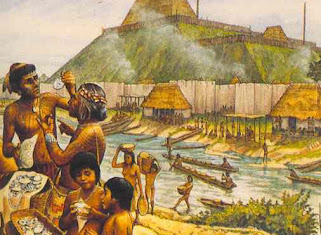
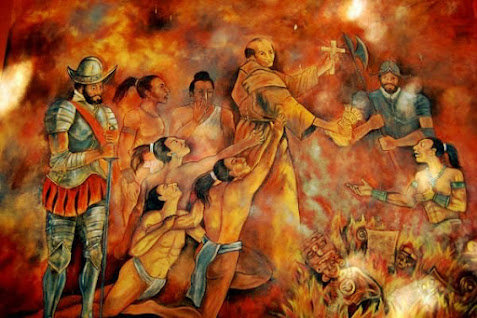
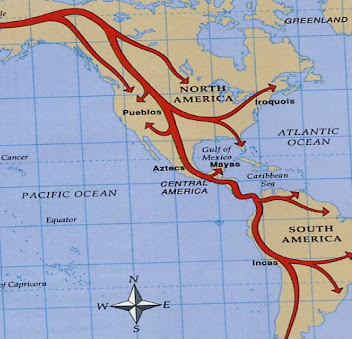

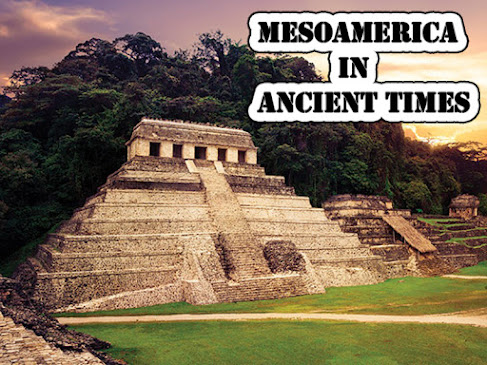
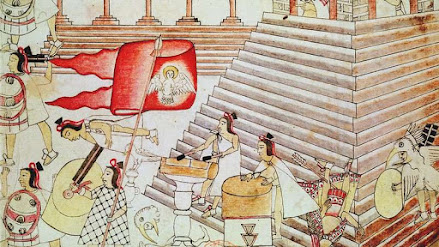
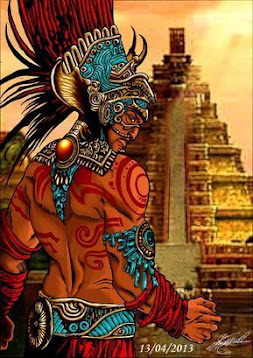
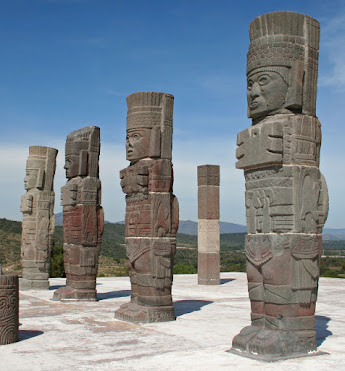











0 Comments